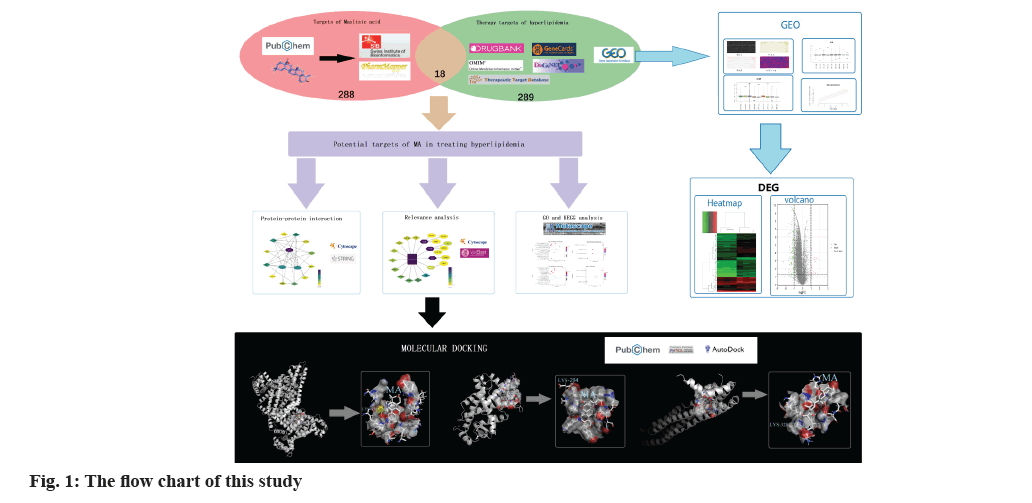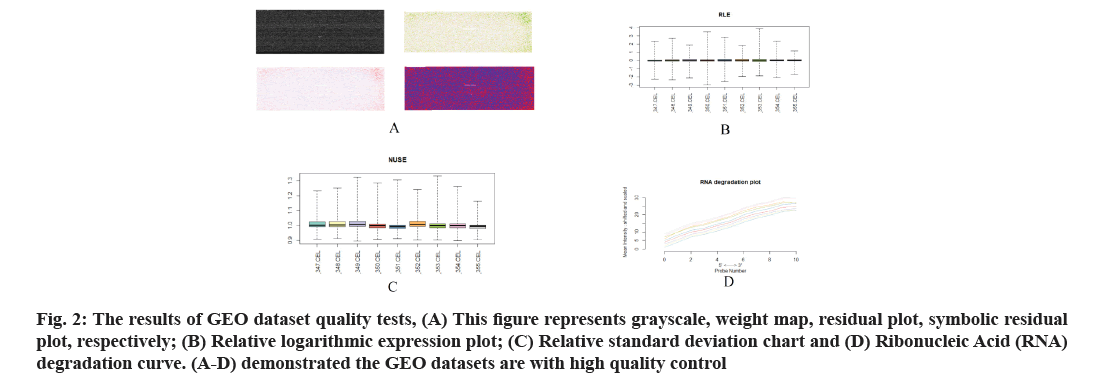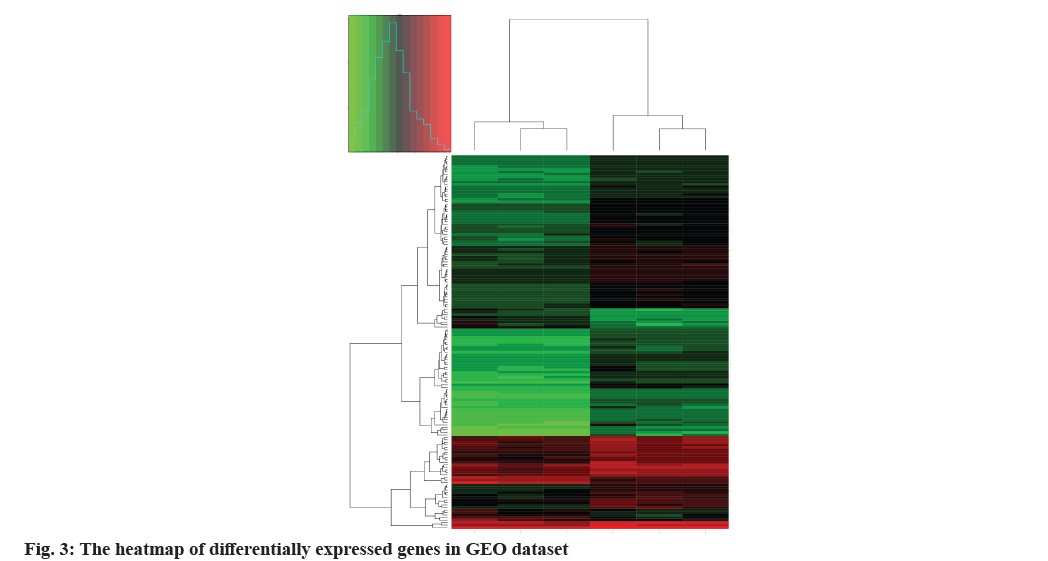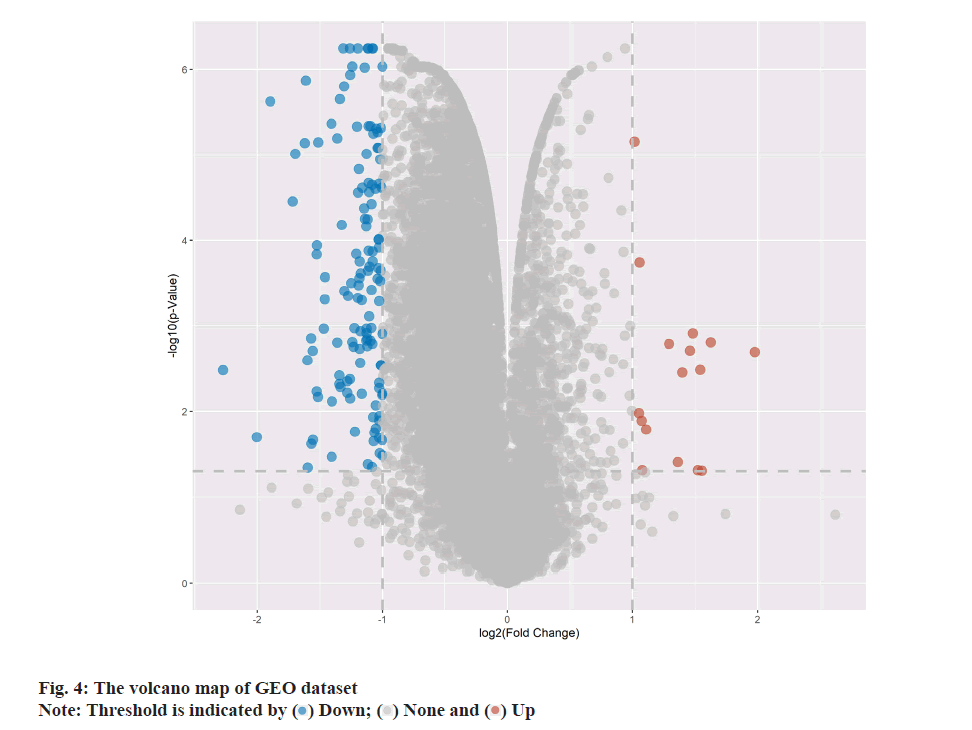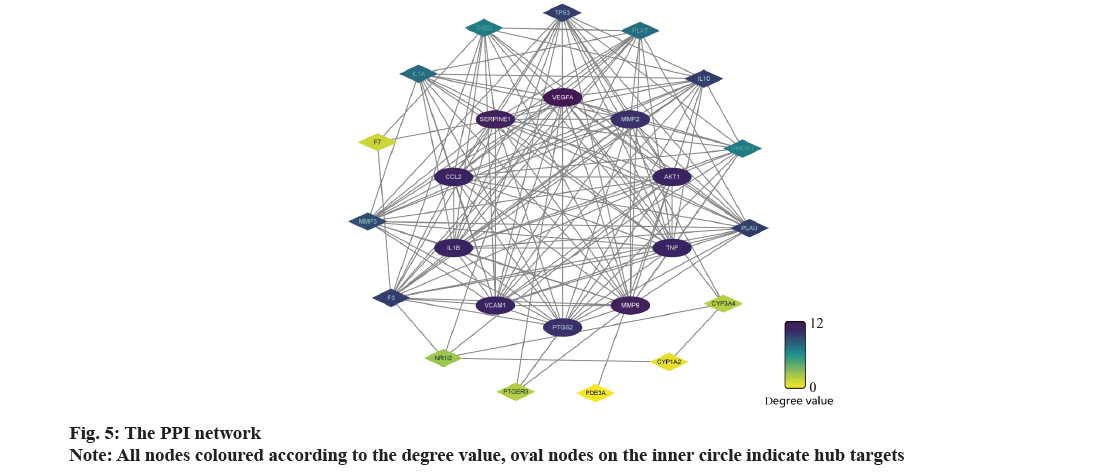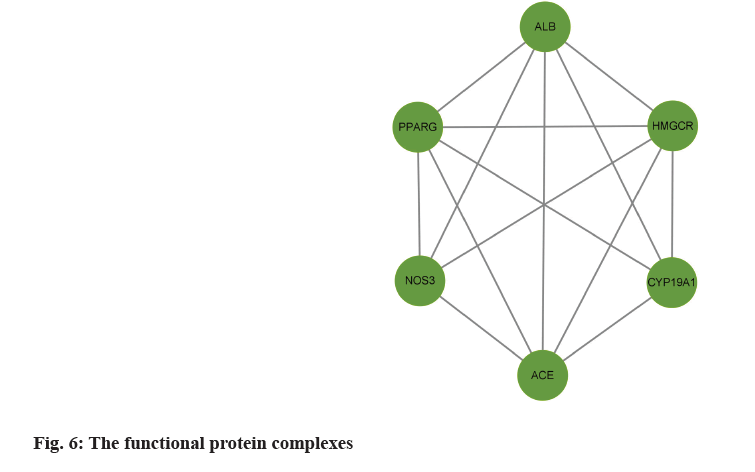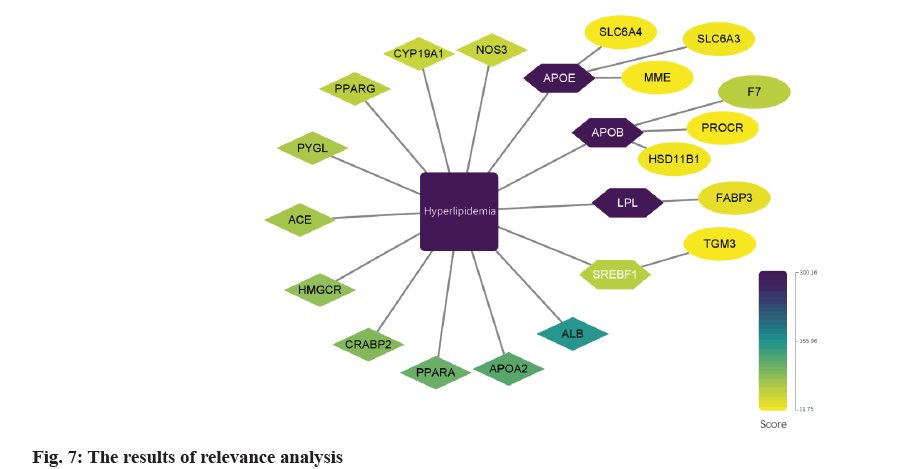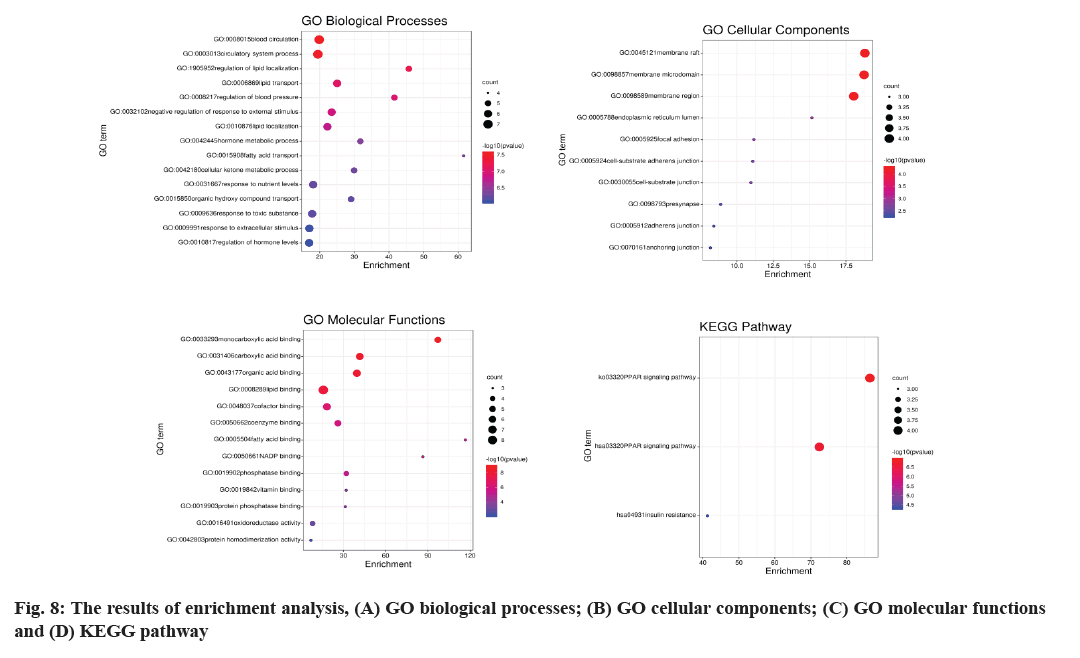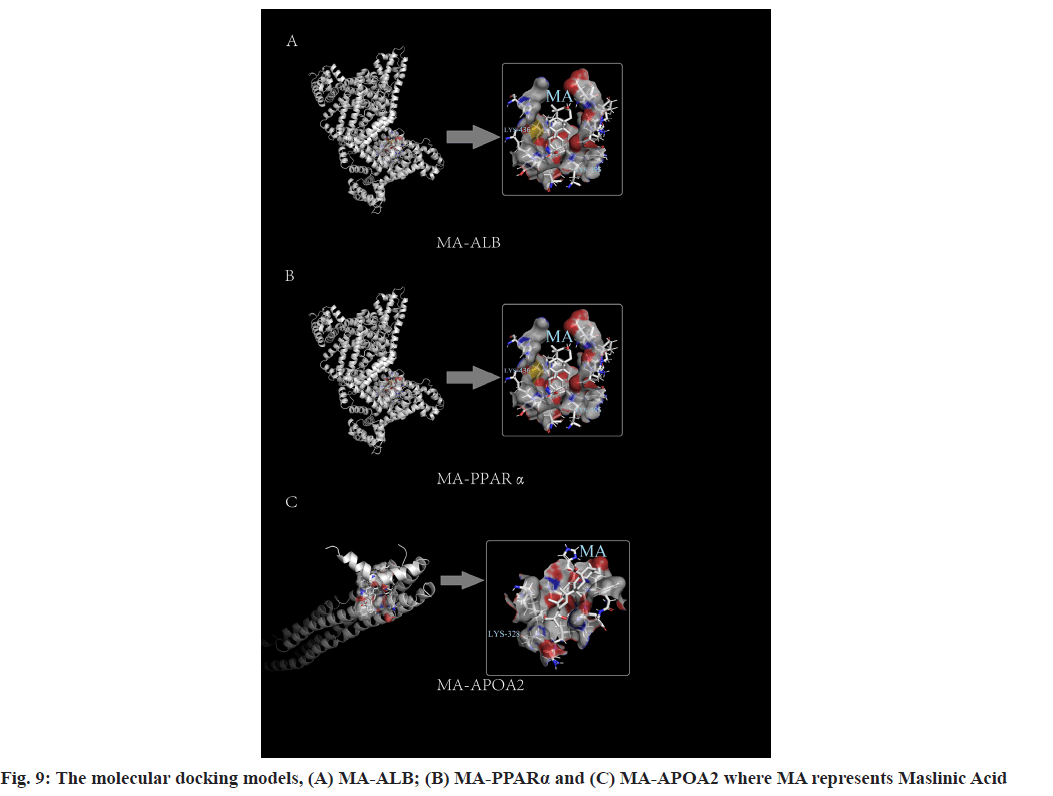- *Corresponding Author:
- Li Zhi Zhao
Department of Cardiovascular Medicine,
The Affiliated Traditional Chinese Medicine Hospital of Southwest Medical University,
China
E-mail: zhaolizhi@swmu.edu.cn
| This article was originally published in a special issue, “Modern Applications in Biomedical Research and Pharmaceutical Sciences” |
| Indian J Pharm Sci 2022:84(3) Spl Issue “162-171” |
This is an open access article distributed under the terms of the Creative Commons Attribution-NonCommercial-ShareAlike 3.0 License, which allows others to remix, tweak, and build upon the work non-commercially, as long as the author is credited and the new creations are licensed under the identical terms
Abstract
Maslinic acid is a pentacyclic triterpenoid acid. Recent research has shown that it has various biological activities such as anti-tumor, hypoglycaemic and hypolipidemic. Among them, the hypolipidemic effect is prominent and this study aims to further explore its mechanism of action in the treatment of hyperlipidemia. The chemical structure of maslinic acid was obtained from PubChem. Based on its chemical structure, the bioavailability and drug-like properties of maslinic acid were analyzed using Swiss absorption, distribution, metabolism and excretion and its potential targets were obtained from SwissTargetPrediction and PharmMapper. Then, the differentially expressed genes between hyperlipidemia patients and the health group were analyzed through the gene expression omnibus data set, and the related targets of hyperlipidemia were complemented using DrugBank, online Mendelian inheritance in man, GeneCards, DisGeNET and therapeutic target databases. Then, the protein-protein interaction network was constructed, the CytoNCA plugin and VarElect were used to screen core targets and metascape was used to systematically analyze the core targets and explore the mechanism. Finally, molecular docking showcased the interaction model. A total of 288 maslinic acid targets and 289 hyperlipidemia-related targets were collected and 18 potential therapeutic targets were found. The enrichment analysis results further systematically explained the effect of maslinic acid on hyperlipidemia. Maslinic acid can treat hyperlipidemia through complex interactions in which the regulation of core genes including albumin, peroxisome proliferator activated receptor alpha and apolipoprotein, and the regulation of peroxisome proliferator activated receptor signaling pathway play a major role.
Keywords
Maslinic acid, atrial fibrillation, network pharmacology, molecular docking, traditional Chinese medicine
In recent years, Cardiovascular Disease (CVD) is the main cause of death in China. Among all CVDs Atherosclerotic Cardiovascular Disease (ASCVD) has increased rapidly and significantly. In 2016, approximately 2.4 million people died from ASCVD, accounting for 61 % of CVD deaths and 25 % of total deaths, compared with 1 million in 1990 (40 % of CVD deaths and 11 % of total deaths) has a larger increase[1]. Dyslipidemia is a common metabolic syndrome, commonly known as hyperlipidemia, characterized by elevated levels of Total Cholesterol (TC), Triglycerides (TGs) and Low-Density Lipoprotein Cholesterol (LDL-C). Decreased High- Density Lipoprotein Cholesterol (HDL-C) is the main manifestation[2] and is the main cause of ASCVD. The incidence of hyperlipidemia is increasing with the continuous improvement of living standards in China. The average level of TC in Chinese adults over 18 y old is 4.70 mmol/l (about 182 mg/dl) and the average level of LDL-C is 2.88 mmol/l. (approximately 111 mg/dl); prevalence of high TC, high LDL-C, high TGs and low HDL-C were 6.9 %, 8.1 %, 13.8 % and 20.4 %, respectively[1]. Hyperlipidemia is an important risk factor for ASCVD. Reducing TGs, TC and LDL-C in blood lipids can significantly reduce ASCVD, CVD morbidity and risk of death[2]. Therefore, effective control of blood lipids is of great significance to prevent and treat ASCVD and improve the quality of life of patients. There is currently no cure for hyperlipidemia and long-term oral drug therapy is required[3]. Atorvastatin, rosuvastatin, simvastatin and other lipid- lowering drugs are commonly used clinical drugs, but they all have adverse reactions such as liver and kidney dysfunction, abnormal glucose tolerance and abnormal digestive function[4,5]. Effective drugs that can be taken for a long time and have less toxic and side effects are an inevitable trend.
Traditional Chinese medicine has unique advantages. Chinese herbal medicine has the characteristics of multi-component and multi-target, which can act synergistically, so as to comprehensively control the disease and has less toxic and side effects[6]. Traditional Chinese medicine treatment of hyperlipidemia mostly uses the methods of removing turbidity and removing blood stasis, strengthening the spleen and removing phlegm, among which hawthorn is the most used unit- flavored traditional Chinese medicine. Maslinic acid is a pentacyclic triterpenoid acid, widely present in many natural plants such as hawthorn, loquat leaves and olive oil, and has various biological activities such as hypolipidemic, antitumor and hypoglycemic activity[7]. It is an ideal alternative or adjuvant drug for the treatment of hyperlipidemia.
Network pharmacology can build a network model of “component-target-disease”, which can predict the targets and signal transduction pathways of drugs and diseases, which is of great significance to the study of the mechanism of action of traditional Chinese medicine[6]. The Gene Expression Omnibus (GEO) database is a collection of selected gene expression datasets and original series and platform records stored in the GEO[8], which combined with network pharmacology can realize the interpretation of drug therapy, disease mechanism and molecular targets[6]. Therefore, this study will systematically analyze the mechanism of action of maslinic acid in the treatment of hyperlipidemia by the method of network pharmacology combined with GEO analysis and verify it by molecular docking (fig. 1).
Materials and Methods
Potential targets of maslinic acid:
Through the structure of maslinic acid, its target absorption and availability, drug-like properties and potential targets can be predicted. PubChem[9] provides online substance and compound search services. Search for maslinic acid in PubChem and download its Structural Data File (SDF).
For oral drugs to exert their efficacy, they must go through the process of Absorption, Distribution, Metabolism and Excretion (ADME) in the human body before they can combine with target organs and target tissues to exert their efficacy[10]. Bioabsorption is multifactorial, but primarily determined by the gastrointestinal absorption potential[11]. Upload the maslinic acid structure to SwissADME for gastrointestinal absorption and drug-like analysis and upload the structure to SwissTargetPrediction and PharmMapper to predict potential targets.
GEO datasets analysis:
The GEO database was searched with “Hyperlipidemia” as the keyword, screened and analyzed using the R software limma program package, including quality control, conversion of probe IDs into gene names, acquisition of expression matrix and finally Fold Change (FC)>2 and p value<0.05 were used as thresholds to screen differential genes and the R language Pretty heatmaps (Pheatmap) program package was used to draw heat maps and the grammar of graphics plot 2 (ggplot2) program package was used to create volcano plots. The differentially expressed gene sets were subjected to name normalization in Universal Protein resource (UniProt).
Therapy targets of hyperlipidemia:
The Online Mendelian Inheritance in Man (OMIM)[12], DrugBank[13], GeneCards[14], DisGeNET[15] and Therapeutic Target Database (TTD)[16] databases provide up-to-date data on human genes and free access to relevant targets for currently known diseases point information. In this paper, hyperlipidemia is used as the key word and the relevant targets of hyperlipidemia are collected in the above databases as supplements. The differentially expressed gene sets mentioned above and the genes obtained from each database are merged and deduplicated and sorted into hyperlipidemia related genes.
Protein-Protein Interaction (PPI) network exploration:
The intersection of the related gene targets of hyperlipidemia and the potential targets of maslinic acid is defined as the potential target of maslinic acid in the treatment of hyperlipidemia.
PPI analysis of related protein targets can make the interactions between proteins clearer, which will help to explain and discover potential protein complexes or function module[17]. Search Tool for the Retrieval of Interacting Genes/Proteins (STRING) is a web-based online tool that provides online analysis of PPIs[17], uploading potential therapeutic targets to STRING to build a PPI network. The results were then imported into Cytoscape (version 3.8.0)[18], the CytoNCA plugin was used to analyze and evaluate the PPI network[19] and Molecular Complex Detection (MCODE) was used to explore potential functional modules in the PPI network.
Relevance of potential targets:
VarElect (http://ve.genecards.org) is an online tool based on the GeneCards database that can analyze the relationship between disease phenotypes and uploaded genes, which can provide relationship analysis based on existing evidence[20]. Import the potential targets of maslinic acid in the treatment of hyperlipidemia into VarElect, analyze the degree of association, export the results and score according to the association method and association degree, and use Cytoscape 3.8. The relationship between lipidemia, the most closely related components will be included in molecular docking for verification.
Functional enrichment analysis:
Thanks to Gene Ontology (GO) and Kyoto Encyclopedia of Genes and Genomes (KEGG), data can be systematically analyzed and new discoveries facilitated[21]. Therefore, in the systematic interpretation of the mechanism of maslinic acid in the treatment of hyperlipidemia, we performed GO and KEGG analysis on the potential targets and functional modules. Metascape is a web-based platform that provides gene annotation, feature enrichment and interactive genomic analysis services, and the database is updated monthly to keep our analysis results current[21]. Upload potential targets to metascape and perform GO biological process, cell component, molecular function and KEGG pathway enrichment analysis. Items with a p value of <0.01 are considered to be significantly enriched.
Molecular docking:
In this paper, molecular docking was used to assess the interaction between maslinic acid and protein targets closely linked to disease. First, the maslinic acid structure was changed to Three Dimensional (3D) form using ChemDraw and saved in Molecule Structure Format (Mol2) after energy minimization. Then, the structures of related proteins were collected from the Protein Data Bank (PDB)[22].
AutoDock[23] and PyMOL[24] will be used for molecular docking and PyMOL will be used to remove water molecules, magazines and extract protein targets. AutoDock is used for hydrogenation and charge calculation of protein targets and hydrogenation of maslinic acid, which is saved as a Protein Data Bank, Partial Charge (Q) and Atom Type (T) (PDBQT) file. Finally, semi-flexible molecular docking was performed using AutoDock to evaluate the binding energy of maslinic acid to the target protein of interest.
Results and Discussion
The structural formula of maslinic acid was downloaded from PubChem and uploaded to SwissADME to evaluate the high gastrointestinal absorption and drug- like properties of maslinic acid. 75 potential targets were obtained through SwissTargetPrediction and after prediction by PharmMapper, the results were uploaded to UniProt for standardization. 238 potential targets were obtained and after the two were combined and deduplicated, a total of 288 potential targets of maslinic acid were obtained.
Taking “Hyperlipidemia” as the key word, after searching in GEO, after screening the title and abstract, it was included in the Genomic Spatial Event (GSE11393) chip, and the original data set and its annotation file GEO Platform (GPL571) were downloaded. A total of 6 samples were analyzed and 3 samples were of hyperlipidemia patient monocytes, 3 samples were healthy control monocytes. R software was used for analysis and processing, and the quality control evaluation was qualified (fig. 2), the probe ID was converted into gene name, the expression matrix was obtained and finally the FC>2 and p value<0.05 were used as thresholds to screen differentially expressed genes. A total of 149 differentially expressed genes were obtained of which 133 were down-regulated and 16 were up-regulated. The heatmap was drawn using the R language Pheatmap program package (fig. 3). Using the ggplot programming package to make a volcano map (fig. 4), normalize the names of the differentially expressed gene sets in UniProt and merge and deduplicate the genes in each database and the differentially expressed gene sets in hyperlipidemia- related genes.
Fig. 2: The results of GEO dataset quality tests, (A) This figure represents grayscale, weight map, residual plot, symbolic residual plot, respectively; (B) Relative logarithmic expression plot; (C) Relative standard deviation chart and (D) Ribonucleic Acid (RNA) degradation curve. (A-D) demonstrated the GEO datasets are with high quality control
Using “Hyperlipidemia” as the keyword, 6, 24, 83, 69 and 1 hyperlipidemia-related targets were obtained from OMIM, DrugBank, GeneCards, DisGeNET and TTD databases, respectively. The differentially expressed genes obtained in GEO datasets analysis and the related genes obtained from the above database were summarized and deduplicated, and a total of 289 hyperlipidemia-related genes were obtained.
A total of 18 potential therapeutic targets of maslinic acid for the treatment of hyperlipidemia were obtained by intersecting the potential targets of maslinic acid with those related to hyperlipidemia.
Upload the relevant targets to STRING for protein interaction analysis. There are 3 potential targets that have no interaction with other potential therapeutic targets. Export the results, import them into Cytoscape and use the CytoNCA plug-in for centrality and correlation evaluation, with the median degree value as the threshold of 6.5, 3 core targets were screened (fig. 5) and a potential protein complex or functional module was found using the MCODE plugin (fig. 6).
Upload 18 potential therapeutic targets to VarElect, set the disease with “Hyperlipidemia” as the key word, after checking, carry out correlation analysis and export the results. Among the 18 potential therapeutic targets, there are 10 targets. There are 8 targets that are directly related to hyperlipidemia and 8 targets are indirectly related to hyperlipidemia. According to the way of association and the targets that are indirectly related play a role, then a target-disease map is drawn to visually express the relationship between targets and diseases (fig. 7), maslinic acid will be molecularly docked with the 3 most closely related targets to verify the relationship.
Upload the potential therapeutic targets to metascape for GO, respectively. Perform GO biological process, cellular components, molecular function and KEGG pathway enrichment analysis, set the p value<0.01, export the results, arrange according to the p value, and export the enrichment analysis chart (fig. 8).
As shown in fig. 8, the therapeutic effect of maslinic acid on hyperlipidemia is mainly through the regulation of blood circulation, lipid transport, lipid localization, hormone metabolism process, fatty acid transport, response to nutrient levels, fatty acid binding, lipid binding and other hyperlipidemia-related pathways.
Similarly, GO and KEGG enrichment analysis was performed on functional modules found in PPI. The main results of this functional module focused on biological processes, including regulation of responses to external stimuli, blood circulation, circulatory system regulation, regulation of blood vessel diameter, regulation of cellular ketone metabolism and lipid localization for lipid transport.
The protein structures of Albumin (ALB) (1AO6), Peroxisome Proliferator Activated Receptor Alpha (PPARA) (1I7G) and Apolipoprotein A2 (APOA2) (3S84) were downloaded from the PDB database respectively, and were imported to PyMOL to remove water, impurities. Autodock were utilized for hydrogenation, calculate the charge and set the protein type. Likewise, the ligand maslinic acid was hydrogenated and the charge was calculated. Subsequently, molecular docking was performed using classical docking to evaluate binding energies (Table 1) and the results were exported and visualized using PyMOL (fig. 9). The binding energy refers to the strength of the binding between the receptor and the ligand, the lower the binding energy, the more stable the docking module.
| Compound | PubChem ID | Target | PDB ID | Binding energy (kcal/mol) |
|---|---|---|---|---|
| Maslinic acid | 73659 | ALB | 1AO6 | -10.2 |
| Maslinic acid | 73659 | PPARA | 1I7G | -9.8 |
| Maslinic acid | 73659 | APOA2 | 3S84 | -9.2 |
Table 1: Details of Molecular Docking
Maslinic acid binds to ALB, PPARA and APOA2 mainly through hydrogen bonds, binds to Lysine 436 (Lys436) and Lys195 of ALB protein through hydrogen bonds, binds to Lys204 of PPARA through hydrogen bonds, and similarly binds to L YS328 of APOA2 through hydrogen bonds.
Hyperlipidemia is a disease of abnormal lipoprotein metabolism in human body, manifested as excessive levels of TC, TGs, LDL-C and HDL-C level is too low. As the main cause of ASCVD, hyperlipidemia needs to be actively controlled to reduce the incidence of ASCVD. Maslinic acid is a pentacyclic triterpenoid acid, which has various biological activities such as anti-tumor, hypoglycemic and hypolipidemic. There are few studies on its hypolipidemic activity and relevant experiments have proved that maslinic acid is effective in reducing blood lipids. However, studies on its mechanism of action are still vacant. Some studies have shown that maslinic acid has a good hypolipidemic effect in non-alcoholic fatty liver model mice, but its specific mechanism and target have not been elucidated[25].
In this paper, the chemical structure of maslinic acid was downloaded through PubChem and the compound was evaluated by SwissADME. It was found that maslinic acid had good gastrointestinal absorption and drug-like properties. 288 potential targets of maslinic acid were obtained through the SwissTargetPrediction and PharmMapper databases. OMIM, DrugBank, GeneCards, DisGeNET and TTD databases were combined with GEO data mining, and a total of 289 hyperlipidemia-related targets were obtained. Discovered 18 potential therapeutic targets, constructed a PPI network to evaluate their associations, drew a target-disease map and intuitively expressed the relevant targets that maslinic acid acts on hyperlipidemia. At the same time, a potential function was found through the MCODE plug-in. The 18 potential therapeutic targets were analyzed for disease association and the 3 targets with the closest association (ALB, APOA2 and PPARA) were subjected to molecular docking verification. The enrichment analysis of potential targets showed that maslinic acid is mainly responsible for regulating blood circulation, lipid transport, lipid localization, hormone metabolism, fatty acid transport, response to nutrient levels, fatty acid binding, lipid binding and other pathways. Lipidemia plays a therapeutic role. Through theanalysis of the potential functional modules, it is found that the regulation of the complex on hyperlipidemia is through the regulation of external stimulus response, blood circulation, circulatory system regulation, regulation of blood vessel diameter and regulation of cellular ketone metabolism and lipid transport, lipid localization and other pathways. A study have shown that maslinic acid can promote the expression of Sirtuin 1 (Sirt1)/Adenosine Monophosphate-activated Protein Kinase (AMPK) and reduce the expression of Sterol Regulatory Element-Binding Protein-1c (SREBP-1c), Peroxisome Proliferator-Activated Receptor gamma (PPARγ), Cytosine-Cytosine-Adenosine-Adenosine- Thymidine (CCAAT)/Enhancer Binding Protein beta (EBP-β) and Fas Cell Surface death receptor (FAS) in hepatocytes, thereby reducing the accumulation of lipids in hepatocytes, thereby improving liver fat which change and significantly reduce its lipid accumulation[26]. Through the core target screening of PPI, it is found that ALB has the highest degree value, relevance and centrality, and is the core target in the PPI network. At the same time, ALB is also the central target of potential functional groups. In conclusion, ALB is the main target of maslinic acid in the treatment of hyperlipidemia. ALB is the most important protein in human plasma. It is closely related to lipid metabolism, transport and metal ion transport. Studies have shown that the expression of ALB in the experimental group using Yinchen Wuling was up-regulated and the levels of TG and LDL-C were significantly decreased, suggesting that ALB has a protective effect on hyperlipidemia[27]. In addition, congenital hypoalbuminemia has a strong impact on lipid metabolism, leading to severe hypercholesterolemia and elevated LDL-cholesterol levels[28]. APOA2 binds to lipids to stabilize HDL structure and affects HDL metabolism, which is closely related to the pathogenesis of dyslipidemia. Studies have shown that APOA2 is the main determinant of HDL-C levels and is a candidate gene for the Quantitative Trait Locus (QTL) of the hyperlipidemia and the up- regulation of APOA2 expression can enhance the pathogenesis of atherosclerosis and reverse cholesterol transport and remove excess cholesterol from the periphery[29-31]. PPARA is a key regulator of lipid metabolism, a receptor for peroxisome proliferators, regulates the peroxisomal β-oxidation pathway of fatty acids and has the functions of lowering blood lipids and fatty acids[32]. A study showed that PPARA gene knockout mice developed obesity in a sexually dimorphic manner and that PPARA had a positive role in preventing hyperlipidemia and fatty liver[33]. Another study showed that decreased PPARA function resulted in increased plasma Apolipoprotein CIII (ApoCIII) concentration and decreased plasma HDL-C concentrations can lead to decreased hepatic Free Fatty Acid (FFA) absorption secondary to decreased expression of Fatty Acid Binding Protein (FABP) and Fatty Acid Transporter (FATP)[34].
However, this study has some limitations. This study aimed to gain insight into the mechanism through network pharmacology and molecular docking techniques. As with other network pharmacology analyses, further studies are required to validate the findings.
Maslinic acid can treat hyperlipidemia through complex interactions in which the regulation of core genes including ALB, PPARA and APOA, and the regulation of PPAR signaling pathway play a major role.
Author’s contributions:
Fei Fei Che and Li Zhi Zhao conceived, designed, planned the study, acquired and analyzed the data. Yi Liang and Wen Chen interpreted the results. Fei Fei Che and Xiao lin Li drafted the manuscript and contributed to the critical revision of the manuscript. All authors read and approved the final manuscript.
Funding:
This work was funded by General Project of Sichuan Provincial Administration of Traditional Chinese Medicine and Research.
Conflict of interests:
The authors declared no conflict of interest.
References
- Zhao D, Liu J, Wang M, Zhang X, Zhou M. Epidemiology of cardiovascular disease in China: Current features and implications. Nat Rev Cardiol 2019;16(4):203-12.
[Crossref] [Google Scholar] [PubMed]
- Joint committee issued Chinese guideline for the management of dyslipidemia. 2016 Chinese guideline for the management of dyslipidemia in adults. Chin J Health Manag 2017;11(1):7-28.
- Wang XG, Zhao X, Li Y, Qu YW, Zhang JJ, Wang MJ, et al. Research progress of pathogenesis and treatment of hyperlipidemia. J Liaoning Univ Tradit Chin Med 2020;(12):196-200.
- Jin H, Kang Z. Lipid-lowering effect and safety of different types of statins in elderly patients with hyperlipidemia. Clin Res Pract 2020;5(32):76-8.
- Li Ming. Study on the therapeutic effect of rosuvastatin and atorvastatin combined with regular exercise on coronary heart disease. Electron J Integr Chin West Med Cardiovasc Dis 2020;8(29):66-76.
- Zhang GB, Li QY, Chen QL, Su SB. Network pharmacology: A new approach for Chinese herbal medicine research. Evid Based Complement Alternat Med 2013;2013:1-9.
[Crossref] [Google Scholar] [PubMed]
- Li X, He YC, Zhou FL. Research progress on the pharmacological effects and mechanisms of maslinic acid. China J Mod Med 2021;8:49-53.
- Barrett T, Wilhite SE, Ledoux P, Evangelista C, Kim IF, Tomashevsky M, et al. NCBI GEO: Archive for functional genomics data sets-update. Nucleic Acids Res 2012;41(1):991-5.
[Crossref] [Google Scholar] [PubMed]
- Kim S, Thiessen PA, Bolton EE, Chen J, Fu G, Gindulyte A, et al. PubChem substance and compound databases. Nucleic Acids Res 2016;44(1):1202-13.
[Crossref] [Google Scholar] [PubMed]
- Daina A, Michielin O, Zoete V. SwissADME: A free web tool to evaluate pharmacokinetics, drug-likeness and medicinal chemistry friendliness of small molecules. Sci Rep 2017;7(1):1-3.
[Crossref] [Google Scholar] [PubMed]
- Newby D, Freitas AA, Ghafourian T. Decision trees to characterize the roles of permeability and solubility on the prediction of oral absorption. Eur J Med Chem 2015;90:751-65.
[Crossref] [Google Scholar] [PubMed]
- Amberger JS, Hamosh A. Searching online mendelian inheritance in man (OMIM): A knowledgebase of human genes and genetic phenotypes. Curr Protoc Bioinformatics 2017;58(1):1-2.
[Crossref] [Google Scholar] [PubMed]
- Wishart DS, Feunang YD, Guo AC, Lo EJ, Marcu A, Grant JR, et al. DrugBank 5.0: A major update to the DrugBank database for 2018. Nucleic Acids Res 2018;46(1):1074-82.
[Crossref] [Google Scholar] [PubMed]
- Stelzer G, Rosen N, Plaschkes I, Zimmerman S, Twik M, Fishilevich S, et al. The GeneCards suite: From gene data mining to disease genome sequence analyses. Curr Protoc Bioinformatics 2016;54(1):1-30.
[Crossref] [Google Scholar] [PubMed]
- Piñero J, Bravo À, Queralt-Rosinach N, Gutiérrez-Sacristán A, Deu-Pons J, Centeno E, et al. DisGeNET: A comprehensive platform integrating information on human disease-associated genes and variants. Nucleic Acids Res 2017;45(1):833-9.
[Crossref] [Google Scholar] [PubMed]
- Chen X, Ji ZL, Chen YZ. TTD: Therapeutic target database. Nucleic Acids Res 2002;30(1):412-5.
[Crossref] [Google Scholar] [PubMed]
- Szklarczyk D, Franceschini A, Wyder S, Forslund K, Heller D, Huerta-Cepas J, et al. STRING v10: Protein-protein interaction networks, integrated over the tree of life. Nucleic Acids Res 2015;43(1):447-52.
[Crossref] [Google Scholar] [PubMed]
- Shannon P, Markiel A, Ozier O, Baliga NS, Wang JT, Ramage D, et al. Cytoscape: A software environment for integrated models of biomolecular interaction networks. Genome Res 2003;13(11):2498-504.
[Crossref] [Google Scholar] [PubMed]
- Tang Y, Li M, Wang J, Pan Y, Wu FX. CytoNCA: A cytoscape plugin for centrality analysis and evaluation of protein interaction networks. Biosystems 2015;127:67-72.
[Crossref] [Google Scholar] [PubMed]
- Stelzer G, Plaschkes I, Oz-Levi D, Alkelai A, Olender T, Zimmerman S, et al. VarElect: The phenotype-based variation prioritizer of the GeneCards suite. BMC Genomics 2016;17(2):195-206.
[Crossref] [Google Scholar] [PubMed]
- Zhou Y, Zhou B, Pache L, Chang M, Khodabakhshi AH, Tanaseichuk O, et al. Metascape provides a biologist-oriented resource for the analysis of systems-level datasets. Nat Commun 2019 3;10(1):1-10.
- Goodsell DS, Zardecki C, Di Costanzo L, Duarte JM, Hudson BP, Persikova I, et al. RCSB Protein Data Bank: Enabling biomedical research and drug discovery. Protein Sci 2020;29(1):52-65.
[Crossref] [Google Scholar] [PubMed]
- Morris GM, Huey R, Olson AJ. Using autodock for ligand?receptor docking. Curr Protoc Bioinformatics 2008;24(1):8-14.
[Crossref] [Google Scholar] [PubMed]
- Rigsby RE, Parker AB. Using the PyMOL application to reinforce visual understanding of protein structure. Biochem Mol Biol Educ 2016;44(5):433-7.
[Crossref] [Google Scholar] [PubMed]
- He F, Zhang X, Wen X. Effects of crataegolic acid on inflammatory response and oxidative stress in non-alcoholic fatty liver disease model mice induced by high-fat diet. China Pharm 2019;30(7):901-5.
- Liou CJ, Dai YW, Wang CL, Fang LW, Huang WC. Maslinic acid protects against obesity?induced nonalcoholic fatty liver disease in mice through regulation of the Sirt1/AMPK signaling pathway. FASEB J 2019;33(11):11791-803.
[Crossref] [Google Scholar] [PubMed]
- Li R, Zhao L, Wu N, Wang R, Cao X, Qiu X, et al. Proteomic analysis allows for identifying targets of yinchenwuling powder in hyperlipidemic rats. J Ethnopharmacol 2016;185:60-7.
[Crossref] [Google Scholar] [PubMed]
- van Rijn JM, Ardy RC, Kulo?lu Z, Härter B, van Haaften-Visser DY, van der Doef HP, et al. Intestinal failure and aberrant lipid metabolism in patients with DGAT1 deficiency. Gastroenterology 2018;155(1):130-43.
[Crossref] [Google Scholar] [PubMed]
- Stewart TP, Kim HY, Saxton AM, Kim JH. Genetic and genomic analysis of hyperlipidemia, obesity and diabetes using (C57BL/6J× TALLYHO/JngJ) F2 mice. BMC Genomics 2010;11(1):1-7.
[Crossref] [Google Scholar] [PubMed]
- Yan Y, He F, Li Z, Xu R, Li T, Su J, et al. The important role of apolipoprotein A-II in ezetimibe driven reduction of high cholesterol diet-induced atherosclerosis. Atherosclerosis 2019;280:99-108.
[Crossref] [Google Scholar] [PubMed]
- Welch CL, Bretschger S, Wen PZ, Mehrabian M, Latib N, Fruchart-Najib J, et al. Novel QTLs for HDL levels identified in mice by controlling for Apoa2 allelic effects: Confirmation of a chromosome 6 locus in a congenic strain. Physiol Genomics 2004;17(1):48-59.
[Crossref] [Google Scholar] [PubMed]
- Blank A, Eidam A, Haag M, Hohmann N, Burhenne J, Schwab M, et al. The NTCP?inhibitor myrcludex B: Effects on bile acid disposition and tenofovir pharmacokinetics. Clin Pharmacol Ther 2018;103(2):341-8.
[Crossref] [Google Scholar] [PubMed]
- Stec DE, Gordon DM, Hipp JA, Hong S, Mitchell ZL, Franco NR, et al. Loss of hepatic PPARα promotes inflammation and serum hyperlipidemia in diet-induced obesity. Am J Physiol Regul Integr Comp Physiol 2019;317(5):733-45.
[Crossref] [Google Scholar] [PubMed]
- Eurlings PM, van der Kallen CJ, Geurts JM, Flavell DM, de Bruin TW. Identification of the PPARA locus on chromosome 22q13.3 as a modifier gene in familial combined hyperlipidemia. Mol Genet Metab 2002;77(4):274-81.
[Crossref] [Google Scholar] [PubMed]
